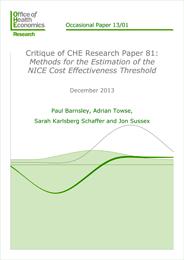Sign up to our newsletter Subscribe
Analysing Global Immunisation Expenditure

This paper counters the recently-published recommendation by Claxton et al[1] that NICE should lower its cost-per-QALY threshold from the current £20,000–£30,000 official range to £12,936.
The Claxton et al paper is an excellent attempt at answering a difficult question, based on a detailed…
This paper counters the recently-published recommendation by Claxton et al[1] that NICE should lower its cost-per-QALY threshold from the current £20,000–£30,000 official range to £12,936.
The Claxton et al paper is an excellent attempt at answering a difficult question, based on a detailed analysis of differences in spending and mortality across Primary Care Trusts (PCTs) throughout England during the 2008–09 financial year. Claxton et al argue that these differences imply that a decrease in PCT spending of £12,936, as a result of NICE approving a new medicine, will lead to the loss of one quality-adjusted life-year (QALY). Therefore, they conclude, NICE should not approve medicines with a cost-per-QALY greater than this threshold.
The critique by OHE’s Barnsley et al accepts the premise that NICE’s cost-effectiveness threshold should be set equal to the budget decrease that would cause the NHS to produce one less QALY. However, it argues that the £12,936 estimate has two serious difficulties: (1) important data are unavailable and therefore assumptions have to be made and (2) the result is very sensitive to those assumptions, several of which Barnsley et al challenge.
The first serious difficulty is with the type of data available. Claxton et al take a snapshot of differences between PCTs and use that to predict changes in spending and mortality within individual PCTs. But this approach would not be justified if PCTs systematically differ in their decision making, e.g. for historical reasons. Furthermore, no data are available on how health spending improves patients’ quality of life. There are only mortality data and those are available only for some areas of spending. As a result, Claxton et al have to estimate quality-adjusted life-years, which they do based on an uncertain and possibly incorrect assumption about the relative skill of PCTs in improving quality of life versus reducing mortality.
The second critical difficulty noted in the critique by Barnsley et al is in the additional assumptions made by Claxton et al. These include, first, assuming that patients whose lives are saved will live as long as healthy people of the same age and, second, that these patients will enjoy better quality of life than the average patient with the same disease. If these assumptions do not hold, then Claxton et al overestimate the success of PCTs in improving health and consequently underestimate the NICE threshold.
[1] Claxton, K., Martin, S., Soares, M., Rice, N., Spackman, E., Hinde, S., Devlin, N., Smith, P.C. and Sculpher, M. (2013) Methods for the estimation of the NICE cost effectiveness threshold. CHE Research Paper 81. Revised report following referees’ comments. York: Centre for Health Economics, University of York.
Critique of CHE Research Paper 81: Methods for the Estimation of the NICE Cost Effectiveness Threshold
Barnsley, P., Towse, A., Karlsberg Schaffer, S. and Sussex, J
(2013) Critique of CHE Research Paper 81: Methods for the Estimation of the NICE Cost Effectiveness Threshold. OHE Occasional Paper. Available from https://www.ohe.org/publications/critique-che-research-paper-81-methods-estimation-nice-cost-effectiveness-threshold/